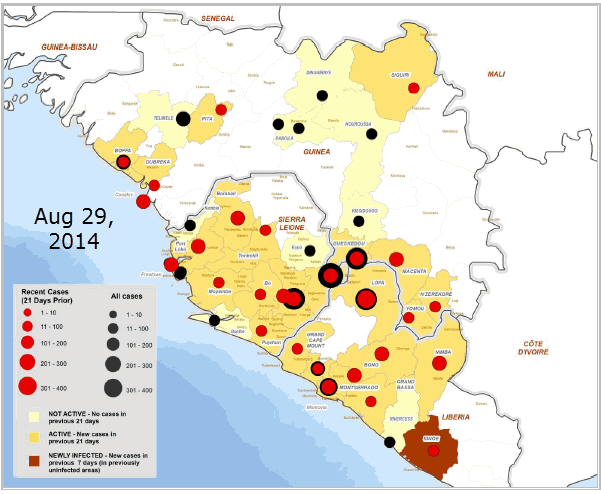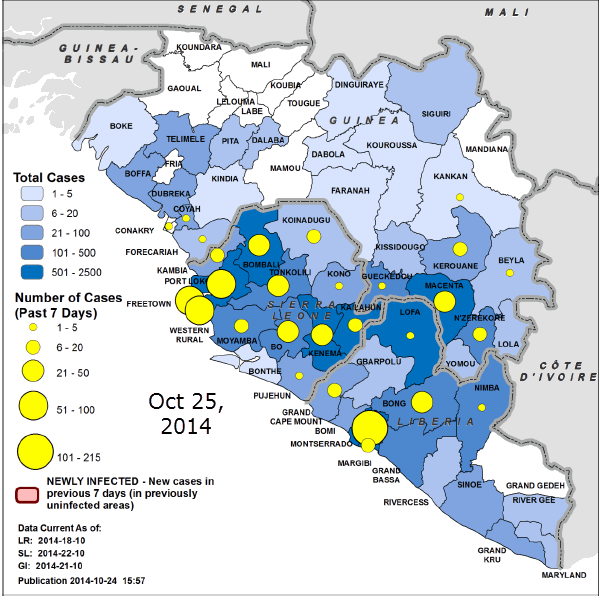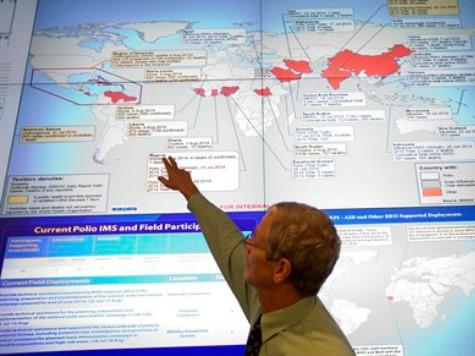
This morning’s key headlines from GenerationalDynamics.com
- World Health Organization says Ebola outbreak is ‘in decline’
- Unanswered questions about the spread of Ebola
- Comparing the Ebola location maps
World Health Organization says Ebola outbreak is ‘in decline’
World Health Organization (WHO) assistant director Bruce Aylward saidthat “we’re seeing a reversal of that rapid rate of increase to thepoint that there seems to be a decline right now.”
He added, “Getting a slight decrease in the number of cases on aday-to-day basis, versus getting this thing closed out, is acompletely different ball game.” This is a highly ambiguousstatement. It could mean that the total number of case is declining,meaning the number of new cases is now smaller than the number ofpeople who are recovering or dying. Or it could mean that the numberof NEW cases has declined, which would mean that the number of newcases is no longer growing exponentially, but has leveled off.
Or it could mean that the number of new cases is still growingexponentially, but at a smaller exponential rate.
The figures that I derived from the WHO situation reports (seethe next item, below) seem to indicate this latter interpretation.A couple of months ago, I was hearing that the number of Ebolacases doubled every 3 weeks. The figures I derived indicate thatthe number doubles every 4.7 weeks which is exponential growthat a slower rate.
A couple of weeks ago, I wrote “Forecasting the Ebola endgame and Global Risk”. I identified several continuing risks aboutEbola — that there could easily be new outbreaks anywhere in theworld in megacities, slums and war zones. None of that is changed byAylward’s statement, and I’m pretty sure that he wouldn’t disagreewith me. Reuters
Unanswered questions about the spread of Ebola
There has been very little Ebola spread out of the threecountries in West Africa. This has led me to wonder if perhapsI was missing something.
The World Health Organization publishes Ebola Situation Reportsevery few days.
I went to the most recent situation report (PDF), dated October 25, 2014. Thefollowing table depicts the total numbers of infections and deaths:
+---------------+--------------+--------- +' Country ' # infections ' # deaths '+---------------+--------------+--------- +' Guinea ' 1553 ' 926 '' Liberia ' 4665 ' 2705 '' Sierra Leone ' 3896 ' 1281 '' Mali ' 1 ' 1 '' Nigeria ' 20 ' 8 '' Senegal ' 1 ' 0 '' Spain ' 1 ' 0 '' U.S. ' 4 ' 1 '+---------------+--------------+--------- +' Total ' 10141 ' 4922 '+---------------+--------------+--------- +
IT seems strange that the only large numbers of cases are in theoriginal countries (Guinea, Liberia, Sierra Leone), and that the onlycases outside of Africa were in Spain and U.S. It doesn’t make senseto me that Ebola hasn’t spread to other countries in Africa, and thatthere haven’t been individual cases in other countries in Europe orAsia or Latin America.
Comparing the Ebola location maps
So, in order to do further analysis, I went back WHO’s originaloriginal situation report (PDF), dated August 29, 2014, and Icompared some of the numbers in the two reports, in order toget an estimate of the growth rate in the number of cases.
If you take the total number of infections — 3052 on August 29, and10,141 on October 25 — and do a computation, then you get that thenumber of infections doubles every 4.7 weeks, which is a little morethan a month (4.25 weeks per month).
If you apply this rate to the number of infections, you get 40K by Jan1, 80K by Feb 1, 160K by Mar 1, and so forth. But can that doublingrate be sustained? The WHO announcement that the outbreak is “indecline” would seem to indicate that it cannot.
So next, I extracted the Ebola location maps from the two reports.
Here’s the August 29, 2014, map:

Ebola location map, 29-Aug-2014 (WHO)
Here’s the October 25, 2014, map:

Ebola location map, 25-Oct-2014 (WHO)
Comparing these two maps, you can see that most infections were in thewest, but they’ve apparently been moving eastward, apparently stoppingat the borders of Mali and Côte d’Ivoire. This is not credible.These country borders are porous, and tribal boundaries do notcorrespond to national boundaries. It’s not credible that the spreadof Ebola has stopped dead at these country borders.
We recently had the news story of the two-year-old infected baby whowas carried on a bus all the way from Liberia to the western border ofMali almost to the eastern border, with multiple stops, including atwo-hour stop in Bamako. Other than the death of the child, we haven’theard anything more about Ebola in Mali. (“25-Oct-14 World View — Two-year-old baby in Mali dies after spreading Ebola”)
At least a few cases of Ebola must surely have spread into these Maliand Côte d’Ivoire, on the border with Liberia, without our being awareof it. If this is true,then there must be unreported cases in these countries.
If there are individual cases in the U.S. and Spain, then there mustbe unreported individual cases in other countries. Considerthe following:
- Cuba has sent hundreds of medical professionals to West Africa.
- China has thousands of workers in the region.
If there have been Ebola cases in the U.S. and Spain, it’s hard tobelieve that Cuba and China would be immune to Ebola cases. What’sdifferent about Cuba and China is that if either has an outbreak ofEbola, it would be covered up and we’d never know,until the outbreak became extremely serious. (This is what happenedin China with the SARS outbreak ten years ago.)
There are plenty of people, including migrant workers, who go back andforth between Africa and their home countries, including Asia andLatin America. Some countries are so undeveloped that officials mightnot even know there’s an Ebola outbreak until it had spread forseveral days.
So there are a lot of unanswered questions about what’s going on.There must be or will be many unreported cases of Ebola, in WestAfrica and elsewhere; it’s not credible to believe otherwise.
Finally, returning to the question of whether the Ebola outbreak isanother possibility is that the only thing that’s declining is thenumber of reporting cases, with sharp increases in the number ofunreported cases. We should have definite answers by the end of theyear. WHO Ebola Situation Reports
KEYS: Generational Dynamics, World Health Organization, WHO,Bruce Aylward, Guinea, Liberia, Sierra Leone, Spain,Cuba, China
Permanent web link to this article
Receive daily World View columns by e-mail

COMMENTS
Please let us know if you're having issues with commenting.